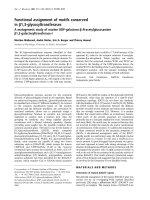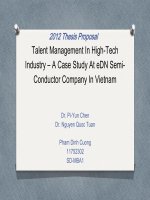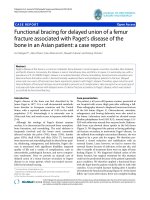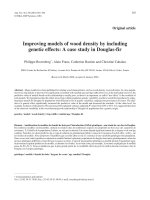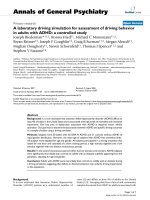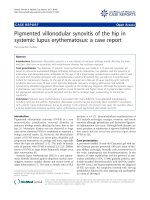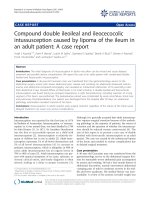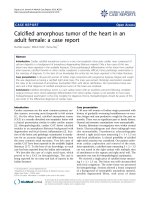Chapter 15 Implementation of ISO 14000 in Luggage Manufacturing Industry: A Case Study
Bạn đang xem bản rút gọn của tài liệu. Xem và tải ngay bản đầy đủ của tài liệu tại đây (200.56 KB, 15 trang )
15
Implementation of ISO 14000 in Luggage
Manufacturing Industry: A Case Study
S. B. Jaju
G. H. Raisoni College of Engineering,
Department of Mechanical Engineering, Nagpur
India
1. Introduction
Definitions of EMS as provided by three separate documents on environmental
management systems are as given below
ISO 14001: "the organizational structure, responsibilities, practices, procedures, processes
and resources for implementing and maintaining environmental management"
BS 7750: "the organizational structure, responsibilities, procedures, processes and resources
for implementing environmental management"
Eco-Management and Audit Scheme (EMAS): "that part of the overall management system
which includes the organizational structure, responsibilities, practices, procedures,
processes and resources for determining and implementing the environmental policy"
2. Development of the ISO 14000 series
The ISO 14000 family includes the ISO 14001 standard, which represents the set of standards
used by various types of organizations for designing and implementing an effective
environmental management system. The major objective of the ISO 14000 series of norms is
"to promote more effective and efficient environmental management in organizations and to
provide useful and usable tools - ones that are cost effective, system-based, and flexible and
reflect the best organizations and the best organizational practices available for gathering,
interpreting and communicating environmentally relevant information".
Unlike previous environmental regulations, which began with command and control
approaches, later replaced with ones based on market mechanisms, ISO 14000 was based on
a voluntary approach to environmental regulation. The series includes the ISO 14001
standard, which provides guidelines for the establishment or improvement of an EMS. The
standard shares many common traits with its predecessor ISO 9000, the international
standard of quality management, which served as a model for its internal structure and both
can be implemented side by side. As with ISO 9000, ISO 14000 acts both as an internal
management tool and as a way of demonstrating a company’s environmental commitment
to its customers and clients.
Prior to the development of the ISO 14000 series, organizations voluntarily constructed their
own EMS systems, but this made comparisons of environmental effects between companies
difficult and therefore the universal ISO 14000 series was developed. An EMS is defined by
www.intechopen.com
298
Environmental Management in Practice
ISO as: “part of the overall management system, that includes organisational structure,
planning activities, responsibilities, practices, procedures, processes and resources for
developing, implementing, achieving and maintaining the environmental policy’.
3. Driving forces
Environmental concerns
For a number of years preceding the introduction of a formal EMS, there was a genuine
concern about its various environmental impacts. Some typical examples of impacts are:
energy and resource usage (electricity, gas , water)
raw material usage (paper, plates, inks, packaging, chemicals, film)
general waste (domestic)
recyclable waste (paper, timber, aluminum, silver, plastics)
hazardous waste (chemical wastes, liquid effluent, air emissions)
nuisances (noise, litter, dust, odors)
contracted activities (transport, subcontracted printing work)
product end use and disposal
Legal obligations
Over recent years, there have been considerable changes in environmental legislation. Every
organisation wants to address its legal obligations, such as compliance with effluent
discharge license parameters, or local authority planning requirements. Integrated Pollution
Control licensing, for instance, will eventually oblige most industries to comply with stricter
industry guidelines on pollution control, with the threat of heavy financial penalties
resulting from non-compliance.
Customer pressure
Lot of pressure is from customer end that is the basic aim of any organisation. Ultimately
customer should have faith in the industry that the said industry is having compliance for
environmental parameters.
4. Basic principles and methodology
The fundamental principle and overall goal of the ISO 14001 standard, is the concept of
continual improvement. ISO 14001 is based on the Plan-Do-Check-Act methodology,
grouped into five phases that relate to Plan-Do-Check-Act; Environmental Policy, Planning,
Implementation & Operation, Checking & Corrective Action and lastly Management
Review.
Plan – establish objectives and processes required
Prior to implementing ISO 14001, an initial review or gap analysis of the organisation’s
processes and products is recommended, to assist in identifying all elements of the current
operation and if possible future operations, that may interact with the environment, termed
environmental aspects. Environmental aspects can include both direct, such as those used
during manufacturing and indirect, such as raw materials (Martin 1998). This review assists
the organisation in establishing their environmental objectives, goals and targets, which
should ideally be measurable; helps with the development of control and management
www.intechopen.com
Implementation of ISO 14000 in
Luggage Manufacturing Industry: A Case Study
299
procedures and processes and serves to highlight any relevant legal requirements, which
can then be built into the policy.
Do – implement the processes
During this stage the organisation identifies the resources required and works out those
members of the organisation responsible for the EMS’ implementation and control. This
includes documentation of all procedures and processes; including operational and
documentation control, the establishment of emergency procedures and responses, and the
education of employees, to ensure they can competently implement the necessary processes
and record results. Communication and participation across all levels of the organisation,
especially top management is a vital part of the implementation phase, with the
effectiveness of the EMS being dependant on active involvement from all employees.
Check – measure and monitor the processes and report results
During the check stage, performance is monitored and periodically measured to ensure that
the organisation’s environmental targets and objectives are being met (Martin 1998). In
addition, internal audits are regularly conducted to ascertain whether the EMS itself is being
implemented properly and whether the processes and procedures are being adequately
maintained and monitored.
Act – take action to improve performance of EMS based on results
After the checking stage, a regular planned management review is conducted to ensure that
the objectives of the EMS are being met, the extent to which they are being met, that
communications are being appropriately managed and to evaluate changing circumstances,
such as legal requirements, in order to make recommendations for further improvement of
the system. These recommendations are then fed back into the planning stage to be
implemented into the EMS moving forward.
5. Role of EMS
1.
2.
An assessment of the existing practices and situation of an organization.
A register of all environmental effects associated with the company's activities,
established through an initial environmental review.
3. A list of all legislation relevant and applicable to the environmental aspects of the
activities, products and services of the organization.
4. Development of a corporate environmental policy and environmental management
plan
5. The setting of environmental performance objectives and targets for both current and
future activities.
6. Development of environmental performance evaluation procedures.
7. Establishment of an effective environmental training program for all employees within
the organization, which will raise awareness, enhance skills for dealing with
environmental issues and stress compliance with relevant legislation.
8. Implementation of a system, which reliably manages the performance of the
organization, for both current and future activities.
9. Documentation of the system communicated to all employees and distributed to all
interested parties, especially to the public.
10. Establishment of non-conformance and corrective and preventive action procedures.
www.intechopen.com
300
Environmental Management in Practice
11. Regular checking, reviewing and auditing of company practices and management
commitment to reflect changing conditions with a focus on continual improvement.
6. Benefits of EMS implementation
6.1 Natural
1. Clean Air, Water, Soil.
2. Prevention and/or significant reduction of pollution and waste Generation.
3. Improved health and safety of interested parties.
4. Reduction in the use of non-renewable resources.
5. Improved conservation and efficient use of natural resources.
6.2 Corporate
1. Reduced financial costs through reduction in consumption of resources and through
waste minimization.
2. Reduction and/or avoidance of potential emergency situations.
3. Avoidance of incidence of non-compliance with legislation and reduction in fines and
cleanup costs.
4. Reduction in the cost of gaining capital, financial backing, insurance and valuation by
becoming an "environmentally friendly" organization.
5. Improved marketing advantage as a "green" operation.
6. Increased staff morale and occupational safety and health standards.
7. Improved customer, client and community relations.
8. Increased documentation, communication and feedback of environmental policies and
initiatives.
7. Major requirements of ISO 14000
Following are some of the requirements of ISO 14000:
1. Environmental protection as one of the highest corporate priorities with clear
assignment of responsibilities and accountabilities to all employees.
2. Compliance with all environmental laws and regulations applicable to the company's
activities, products and services.
3. Ongoing communications on environmental commitment and performance with all
shareholders.
4. Strategic planning that sets forth environmental performance objectives and targets,
implemented through a disciplined management process.
5. Periodic performance measurement (as well as systems audits and management
reviews) to achieve continual improvement wherever possible.
6. Full integration with health and safety, quality, finance, business planning and other
essential management processes.
7. Focus on EMS and looks for attributes that would sustain sound environmental
decision making and performance.
8. Top management commitment.
9. Third-party registration, through ISO 14001, or self-declaration for companies that meet
the ISO 14000 standards. ISO 14001 includes discrete elements of environmental
aspects, legal requirements, objectives and targets, environmental management
program, communications, and emergency preparedness and response.
www.intechopen.com
Implementation of ISO 14000 in
Luggage Manufacturing Industry: A Case Study
301
8. Stage by stage implementation of ISO 14001
First stage: commitment and policy
i.
Environmental policy
Second stage: Planning
i.
ii.
iii.
iv.
Environmental aspects
Legal and other requirements
Objectives and targets
Environmental management program
Third stage: Implementation
i.
ii.
iii.
iv.
v.
Structure and responsibility
Training, awareness and competence
Communication
Environmental documentation
Document control
Fourth stage: Operational control measurement and evaluation
i.
ii.
iii.
iv.
Monitoring and measurement
Non-conformance and corrective and preventive action
Records
Environmental management system audit
Fifth stage: Review and improvement
i.
Management review
9. Benefits of developing ISO 14000 series
1.
2.
3.
4.
Having a single, global set of environmental management system guidance standards.
The development of a common, global approach to voluntary and self-directed
environmental management.
Enhancement of the ability to measure levels of sustainability and environmental
performance through auditing methods.
Harmonization of non-uniform standards for a range of environmental impact issues.
10. Implelementation OF ISO 14000 in luggage manufacturing industry:
The study is done for Canteen and Tools and Mould repairing.
CANTEEN: Firstly the various input to canteen are identified viz. Vegetables, spices, oil,
food grains, water, LPG gas, Electricity. Output of the canteen is Food products.
The various effects of the canteen on the environment as a whole are identified
1. Used water discharged to drainage.
2. Fire in L. P. G. (Emergency).
3. Solid waste non biodegradable (Carboys, drums, containers, empty milk bags).
4. Solid waste biodegradable (spent food and vegetables).
5. Fume generation.
6. Heat loss to atmosphere.
www.intechopen.com
302
Environmental Management in Practice
7. Noise generation.
The complete canteen as process showing input and output as well its effects on
environment are tabulated in aspect register as shown in Table I.
Each aspect is studied carefully for the following category of aspects:
1. Normal aspects: Effects of aspects are negligible.
2. Abnormal Aspects: Severe effect on environment.
3. Emergency Aspects: Nature of Aspect is emergency. Emergency prepared plan has to
be there. Proper training to be given to the people for handling the emergency
situations. They should be equipped with safety devices to tackle the emergency. For
example: Suppose if there is a fire hazard. Whether the fire fighting equipment is there
or not. If it is there then whether the people are trained to operate it and so on.
Emergency preparedness plan for every department, which will consist of the following few
points:
1. Fire equipments are available or not that too in proper place.
2. Are the people trained to handle the situations?
3. Security people should be trained.
4. First aid training is to be given to all.
5. Fire equipments layout, number of fire equipments, is to be planned.
6. Emergency siren should start immediately after the fire.
7. All people should assemble at one place.
Factor rating is applied to each aspect depending on various factors. The various ratings
used are
A: Occurrence
Continuous (8hours & above)/day
5
Less than 8 hours/day
4
Less than 8 hours/week
3
Less than 8 hours/month
2
Less than 8 hours/year
1
C: Significance of Impact
Causing death to human being on site/ offsite, damage
to flora fauna, air, water, land (offsite).
5
Damage to flora fauna, air, water, land or
hospitilisation to human being on site.
4
Damage to flora fauna, air, water, land or first aid to
human being on shop
3
Damage to flora fauna, air, water, land and or first aid
to human being on shop
2
Negligible impact
1
www.intechopen.com
Implementation of ISO 14000 in
Luggage Manufacturing Industry: A Case Study
303
D: Controls
Controls absent
Controls present
Controls present but needs human intervention
Controls present no human intervention
Closed loop control
5
4
3
2
1
E: Frequency of Detection
Once in a year & above
Once in six months
Once in one to three months
Once in a week
Once in a day
5
4
3
2
1
F: Category of waste
Hazardous waste
Non-hazardous waste (High)
Non-hazardous waste (Low)
100% recycled in house or recycled from outside party
for inside use
Negligible waste generation
5
4
3
2
1
The factor rating of impacts for each aspect is shown in Table II.
After categorisation of aspects, their impact has to be ascertained. Then whether they can be
measured or not. If measured, what is the present status? Then the frequency of occurrence
is to be known. Further what is the treatment given to nullify the bad effects of aspects on
environment? All these analysis is depicted in Table III.
After rating and critical analysis of each aspect one should have the action plan for the
aspect, which is affecting severely on environment. Meetings should be conducted to take
reviews on the improvement after the implementation of action plan. The improved status
to be maintained and periodic review are done to ascertain.
In the similar way study is carried out for process of TOOL AND MOULD REPAIR and the
reports are shown in Table IV, V and VI.
11. Conclusion
With the implementation of EMS, communications concerning environmental practices were
streamlined. It was possible to identify areas where utility savings existed. EMS defined
roles and responsibilities towards each aspect of the process and their impacts on the
environment. A systematic approach is understood to handle environmental issues in place
and the overall plant cost savings coming from tracking resources and accounting for them.
The EMS also provides the more intangible benefit of employee taking pride of working in
the plant that is a good environmental neighbour.
www.intechopen.com
304
Environmental Management in Practice
Table No. I
LUGGAGE INDUSTRIES LTD.
SHEET No.
ASPECT REGISTER
DOC No. : ASP – 27
Dept. : Pers & Admn
Process :- Canteen
Fume Generation
Heat loss to atmosphere
ISSUE DATE
:
:
1 of 3
1-08-2003
REV No.
:
00
REV. DATE
:
00
Noise Generation
Vegetables, spices,
Water Consumption
CANTEEN
Food products
L.P.G. Gas
Electricity
Fire in L.P.G. (Emergency)
Used water discharged to drainage
Solid waste biodegradable
(spent food and Vegetable)
Solid waste non biodegradable
(carboys, drums, containers, empty milk bags)
Prepared by :
www.intechopen.com
Approved By :
Implementation of ISO 14000 in
Luggage Manufacturing Industry: A Case Study
305
Table No. II
LUGGAGE
INDUSTRIES LTD.
Dept. : Pers & Admn
Process :- Canteen
Sr.
ASPECT
No.
01
02
03
04
05
06
Fume
Generation
Heat loss
Noise
generation
Discharge of
used water
Solid waste
biodegradable
spent food
vegetable
Solid waste
non
biodegradable
corboys drums
containers etc.
SHEET No.
:
3 of 3
ASPECT REGISTER
DOC No. : ASP – 27
ISSUE DATE
:
1-08-2003
REV No.
:
00
REV. DATE
:
00
FACTOR RATING
TOTAL
IS IT
RATING SIGNIFICANT
B
C
D
E
F
NORMAL ASPECTS
A
5
1
1
2
5
1
15
No
5
1
1
2
5
1
15
No
-- -- -- -- -- S T A T U T O R Y -- -- -- -- --
YES
5
3
1
3
3
3
18
YES
5
3
1
3
3
3
18
YES
2
1
1
3
3
3
13
No
Nil
No
ABNORMAL ASPECTS
07
Nil
Fire in L.P.G.
Storage area
Prepared by :
Nil
Nil Nil Nil Nil Nil
EMERGENCY ASPECTS
YES
08
www.intechopen.com
Approved By :
306
Environmental Management in Practice
Table No. III
LUGGAGE INDUSTRIES LTD.
Dept. : Pers & Admn
Process :- Canteen
Sr.
No.
01
02
03
04
05
06
07
08
Aspect
www.intechopen.com
Measur.
Indicator
:
:
2 of 3
1-08-2003
:
00
:
00
Present
Frequency of
Present Type of
Remarks
status
treatment control
reference
Occur
Meas
NORMAL ASPECTS
Fume
Air Pollution
Not
Not
Cont.
Not
Nil
Nil
Nil
generation
measured measured
Measured
Heat
Ambient
Deg.
Not
Cont.
Not
Nil
Nil
Nil
loss
warming
Celsius
measurable
measurable
Noise
Noise
dB
72 dB
Cont. Negligible
Nil
Statutory Noise level
generation
pollution
report
Solid waste
Kgs/Day 45 –50 kgs Cont. Once in a Disposed
Land
Self
EMP-P&A01
biodegradable Contamination
day
to animal
feeder
spent food
and vegetable
Discharge of
Daily
Not
Disposed
Self
EMP-P&A02
Water
K Ltrs.
Not
used water to
measured to sewage
pollution
measured
drainage
Cont. Once in a Disposed
Land
Solid waste
Nos./month 18 Tins
Self
Nil
contamination
non20 Gunny
month
to
biodegradable
bags
recyclers
900 milk
carboys,
drums,
bags
containers
ABNORMAL ASPECTS
Nil
Nil
Nil
Nil
Nil
Nil
Nil
Nil
Nil
EMERGENCY ASPECTS
Fire in L.P.G.
Damage to
No incident
Emergency
storage area flora fauna, air,
so far
preparedness
land, human
& response
being & assets
plan
Prepared by :
Impact
SHEET No.
ASPECT REGISTER ISSUE DATE
DOC No. : ASP – 27
REV No.
REV. DATE
Approved By :
Implementation of ISO 14000 in
Luggage Manufacturing Industry: A Case Study
307
Table No. IV
SHEET No.
LUGGAGE INDUSTRIES LTD
Dept. : Tool Room
ASPECT REGISTER
DOC No. : ASP – 13
Process :- Tool / Mould Repairing
:
ISSUE DATE
:
REV No.
REV. DATE
1 of 3
1-08-2003
:
:
01
18/01/2004
Noise generation
Dust generation
M.S. Plate, Steel round,
Copper plate / round,
Graphite blocks, Water for
machine coolant, machine
oil
Heat loss to atmosphere
TOOLS & MOULD REPAIRING
Finished /
Semifinished Tools & Moulds
Cotton waste
Chips generation
Prepared by :
www.intechopen.com
Coolant / Oil leakage
Approved By :
308
Environmental Management in Practice
Table No. V
LUGGAGE INDUSTRIES
LTD
Dept. : Tool Room
SHEET No.
ISSUE DATE
ASPECT REGISTER
DOC No. : ASP – 13
ASPECT
01
05
06
Noise generation
Heat loss to
atmosphere
Dust generation
Cotton waste
generation
Metal scrap
Spent coolant
07
Oil leakage
08
Nil
02
03
04
REV. DATE
FACTOR RATING
B
C D
E
F
NORMAL ASPECTS
A
1-08-2003
:
:
01
18/01/2004
IS IT
SIGNIFICANT
-- -- -- -- -- S T A T U T O R Y -- -- -- -- --
YES
5
1
1
3
5
1
16
NO
3
1
1
5
5
1
16
NO
5
1
1
3
3
3
16
NO
5
1
1
3
3
1
14
-- -- -- -- -- S T A T U T O R Y -- -- -- -- -ABNORMAL ASPECTS
NO
YES
-- -- -- -- -- S T A T U T O R Y -- -- -- -- -EMERGENCY ASPECTS
YES
Nil Nil Nil Nil Nil Nil
Prepared by :
www.intechopen.com
TOTAL
RATING
3 of 3
:
REV No.
Process :- Tool/ Mould
Repairing
Sr. No.
:
Nil
Approved By :
nil
Implementation of ISO 14000 in
Luggage Manufacturing Industry: A Case Study
309
Table No. VI
SHEET No.
LUGGAGE INDUSTRIES LTD.
:
ISSUE DATE
Dept. : Tool Room
ASPECT REGISTER
DOC No. : ASP – 13
Process :- Tool / Mould
Repairing
:
1-08-2003
REV No.
REV. DATE
Frequency of
Present
status
Occur
Meas
NORMAL ASPECTS
Present
treatment
2 of 3
:
:
01
18/01/2004
Type of
control
Remarks
reference
Sr.
No.
Aspect
Impact
Measur.
Indicator
01
Noise
generation
Noise
pollution
dB
80
Cont.
Once in 6
months
Nil
02
Dust
generation
(By
Grinding)
Air
Pollution
Mg./Nm3
Negligible
Cont.
Not
measured
Nil
Nil
Nil
03
Heat loss to
atmosphere
Ambient
warming
Max. 5C
Not
above
Cont.
Measured
ambient
te perature
Nil
Nil
Nil
04
05
Cotton
Land
waste
Contamination
generation
Metal
Land
scrap
Contamination
Cent.
Measurement
Statutory of noise level
report
Kgs
Approx. 60
Cont.
Kgs/Month
Monthly
Disposed to
recyclers
Nil
Monthly issue
from store
Kgs.
Appr x. 30
Cont.
Kgs/Month
Monthly
Disposed to
recyclers
Nil
Scrap ticket
06
Spent
coolant
Water
pollution
Ltrs.
07
Oil leakage
Land
Contamination
Ltrs.
08
Nil
Nil
Nil
Approx. 30
Cont.
Ltr./Month
Monthly
Effluent
treatment
plant
Register for
spent coolant
Statutory
to powder
coating
ABNORMAL ASPECTS
Prepared by :
www.intechopen.com
Secondary
Not
Statutory
Measured containment
EMERGENCY ASPECTS
Nil
Nil
Nil
Nil
Nil
Negligible
Rare
Approved By :
Nil
nil
310
Environmental Management in Practice
12. References
[1] Ambika Zutshi and Amrik S. Sohal, (2000), Environmental management systems auditing:
auditors’ experiences in Australia, Int. J. Environment and Sustainable Development,
Vol. 1, No. 1, pp 73-87.
[2] Subhash Babu, A., Madhu, K. and Sahani, N. (1998), Positioning ISO 14000 standards an
investigative study covering selected Indian Industries, Proc. ISME Conference, Dec
1998, IIT Delhi, pp 286-291.
[3] Fabio Orecchini, (2000), The ISO 14001 certification of a machine process, Journal of Cleaner
Production, Vol. 8, Issue 1, February 2000, pp 61-68.
[4] Martin, R 1998, ISO 14001 Guidance Manual, National Centre for environmental
decision-making research: Technical report, viewed 23 August 2010
[5] Company manual.
www.intechopen.com
Environmental Management in Practice
Edited by Dr. Elzbieta Broniewicz
ISBN 978-953-307-358-3
Hard cover, 448 pages
Publisher InTech
Published online 21, June, 2011
Published in print edition June, 2011
In recent years the topic of environmental management has become very common. In sustainable
development conditions, central and local governments much more often notice the need of acting in ways that
diminish negative impact on environment. Environmental management may take place on many different
levels - starting from global level, e.g. climate changes, through national and regional level (environmental
policy) and ending on micro level. This publication shows many examples of environmental management. The
diversity of presented aspects within environmental management and approaching the subject from the
perspective of various countries contributes greatly to the development of environmental management field of
research.
How to reference
In order to correctly reference this scholarly work, feel free to copy and paste the following:
S. B. Jaju (2011). Implementation of ISO 14000 in Luggage Manufacturing Industry: A Case Study,
Environmental Management in Practice, Dr. Elzbieta Broniewicz (Ed.), ISBN: 978-953-307-358-3, InTech,
Available from: />
InTech Europe
University Campus STeP Ri
Slavka Krautzeka 83/A
51000 Rijeka, Croatia
Phone: +385 (51) 770 447
Fax: +385 (51) 686 166
www.intechopen.com
InTech China
Unit 405, Office Block, Hotel Equatorial Shanghai
No.65, Yan An Road (West), Shanghai, 200040, China
Phone: +86-21-62489820
Fax: +86-21-62489821
